Click on images to enlarge
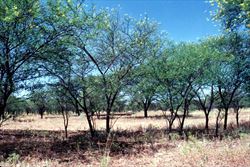
infestation (Photo: Land Protection, QDNRW)

habit (Photo: Land Protection, QDNRW)
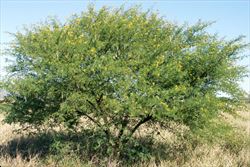
habit in flower (Photo: Chris Gardiner)
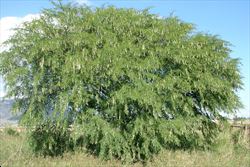
habit in fruit (Photo: Chris Gardiner)

older stems covered in tiny whitish spots (Photo: Sheldon Navie)
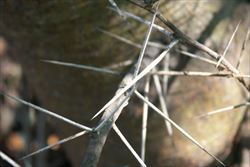
close-up of large greyish-coloured spines (Photo: Chris Gardiner)
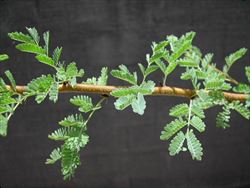
twice-compound leaves (Photo: Sheldon Navie)
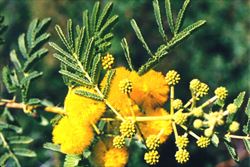
leaves and flower clusters (Photo: Land Protection, QDNRW)

close-up of globular flower clusters and flower buds (Photo: Chris Gardiner)
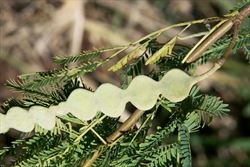
close-up of immature fruit (Photo: Chris Gardiner)

mature fruit (Photo: Land Protection, QDNRW)

old fruit on the ground (Photo: Chris Gardiner)
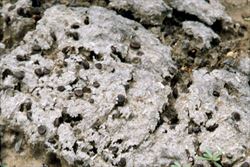
seeds in cow dung (Photo: Land Protection, QDNRW)

seedlings (Photo: Chris Gardiner)
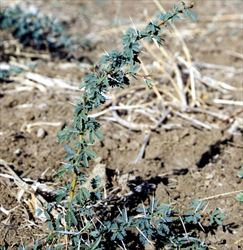
young plant (Photo: Land Protection, QDNRW)
Scientific Name
Vachellia nilotica (L.) P.J.Hurter & Mabb.
Synonyms
Acacia nilotica (L.) Willd. ex Delile subsp. indica (Benth.) Brenan
Acacia arabica (Lam.) Willd. var. indica Benth.
Acacia indica Benth.
Acacia nilotica (L.) Willd. ex Delile
Acacia nilotica (L.) Willd. ex Delile var. indica A.F. Hill
Mimosa nilotica L.
Family
Fabaceae: sub-family Mimosoideae (New South Wales)
Leguminosae (South Australia)
Mimosaceae (Queensland, the ACT, Victoria, Tasmania, Western Australia and the Northern Territory)
Common Names
algaroba, babul, babul acacia, black thorn, blackthorn, Egyptian acacia, Egyptian thorn, gum arabic tree, gum-arabic tree, Indian gum-arabic tree, Nile acacia, prickly acacia, prickly mimosa, scented pod acacia, scented-thorn, thorny acacia, thorn-mimosa
Origin
Prickly acacia (Vachellia nilotica) is native to the arid and semi-arid regions of Africa and western Asia, the Indian sub-continent (i.e. India, Pakistan and Myanmar) and the Arabian peninsula (i.e. Oman and Yemem).
Cultivation
This species was initially introduced as a source of 'gum arabic' and at one time was deliberately cultivated as a fodder and shade plant for livestock in semi-arid pastures in Queensland (particularly in the mitchell grass plains where there was virtually no natural tree cover). It has also occasionally been grown as a garden ornamental in the past, particularly in drier inland areas.
Naturalised Distribution
This species is widely naturalised in Queensland and is most common and widespread in the north-western and central-western areas of this state. Major infestations occur from Barcaldine north to Hughenden and west to Longreach, Winton and Julia Creek. It is also naturalised to a lesser extent in the northern and eastern parts of the Northern Territory, in northern Western Australia, and in north-eastern South Australia. In the north-east of the Northern Territory is is found mostly on properties along the Barkly Highway. In northern Western Australia it has recently been found infesting a few areas near Kununurra in the Kimberley region. In north-eastern South Australia there is a single large infestation at cordillo Downs. Scattered infestations are also present in other parts of Queensland (i.e. along the coast and in southern Queensland) and the Northern Territory (i.e. in the Katherine district). There are also reports of it being present in some inland regions of northern New South Wales, although no herbarium specimens have been collected from this area.
Prickly acacia (Vachellia nilotica) has become naturalised in other parts of the world, includign eastern Indonesia and the Galapagos Islands. This species is also considered to be a weed in some parts of southern Africa (i.e. within its native range).
Habitat
Prickly acacia (Vachellia nilotica) prefers semi-arid, warmer temperate, and sub-tropical regions but is also found in tropical environments and will grow near water sources in arid areas. It is most commonly found growing in grasslands, pastures and open woodlands. Within these plant communities it inhabits floodplains, open plains, gullies, areas near waterways (i.e. creeks and streams) and areas near other water sources (i.e. dams and bores). It also grows on recently cleared land, near stockyards and farm buildings, and along roadsides.
Habit
A large spreading multi-stemmed shrub or small upright (i.e. erect) single-stemmed tree usually growing 2.5-7 m tall, but occasionally reaching up to 14 m in height.
Distinguishing Features
- a thorny shrub or small tree with twice-compound leaves.
- a pair of greyish-coloured spines (2-50 mm long) is usually present near the base of each leaf.
- its yellow or golden-yellow flowers are borne in small dense globular clusters (8-15 mm across) in the leaf forks.
- its large, elongated, and greyish-green pods (6-25 cm long) are deeply constricted between each of the seeds (i.e. they resemble a string of pearls).
Seedling
The seedlings have two undivided seed leaves (i.e. cotyledons) that are borne above soil level and tend to fall off early. The first true leaves are twice-compound (i.e. bipinnate), but have only one or two pairs of branchlets (i.e. pinnae), each bearing several pairs of tiny leaflets (i.e. pinnules).
Stems and Leaves
The stems are whitish and either hairy or occasionally hairless when young, but turn a darker colour (i.e. grey to brown) as they age and become woody. They are usually covered in tiny whitish-coloured raised spots (i.e. lenticels). The trunks of mature trees are rough with fissured bark towards their base that is brown, reddish-brown or black in colour. Pairs of stout greyish-coloured spines (2-50 mm long, occasionally up to 10 cm in length) are borne at the base of each leaf (i.e. near the leaf axils). Sometimes these spines may be inconspicuous (i.e. they may occasionally appear to be absent from some branches), and they are usually absent from the trunks and older branches.
The twice-compound (i.e. bipinnate) leaves are dark green in colour and have a feathery appearance. They are borne on a relatively short leaf stalk (i.e. petiole) 4-20 mm long, which is finely hairy and sometimes has a small raised structure (i.e. gland) just below the lowest pair of leaf branchlets (i.e. pinnae). The extension of the leaf stalk (i.e. rachis) is 8-68 mm long and bears 2-10 pairs of small leaf branchlets (i.e. pinnae). A small raised gland is usually present on the rachis, at the junction of the uppermost one or two pairs of leaf branchlets (i.e. pinnae). Each of the leaf branchlets (1-5 cm long) bears numerous (7-30) pairs of small, oblong or narrowly oblong leaflets (i.e. pinnules). These leaflets (2-7 mm long and 0.5-2 mm wide) are usually hairless (i.e. glabrous), but sometimes have somewhat hairy (i.e. ciliate) margins, and have rounded tips (i.e. obtuse apices).
Flowers and Fruit
The small yellow or golden-yellow flowers are densely arranged into small globular clusters (6-15 mm across). Each individual flower has four or five relatively inconspicuous petals and sepals and numerous conspicuous stamens that give the flower clusters a very fluffy appearance. The globular flower clusters contain 30-50 of these flowers and are borne on hairy stalks (i.e. peduncles). These stalks (7-32 mm long) emanate from the leaf forks (i.e. axils) and usually have some tiny bracts about half way along them. The flower clusters are borne in groups of two to six in each leaf fork (i.e. axil). Flowering occurs throughout the year, but is most abundant during autumn and winter (i.e. from March to July).
The fruit is an elongated pod (6-25 cm long and 4-17 mm wide) that is swollen around each seed and strongly constricted between the seeds (i.e. it is torulose), and therefore resembles a string of pearls. These greyish-green pods are covered in tiny soft hairs (i.e. thye are pubescent), are somewhat flattened, and turn green to brown in colour when mature. However, very old pods may turn dark brown or black in colour after being shed from the plant. They contain several (8-15) seeds, do not split open at maturity (i.e. they are indehiscent), and are most commonly present during late winter, spring and summer (i.e. from May to January). The brown or blackish-brown coloured seeds (6-7 mm long and 4.5-6.5 mm wide) are almost round in shape (i.e. sub-globular) and somewhat flattened. They are smooth in texture and have a hard seed coat.
Reproduction and Dispersal
This plant reproduces by seed, which can remain dormant in the soil for long periods. It is also capable of regenerating from the crown when trees are cut, or after being damaged by fire.
Seeds are most often dispersed after being eaten by large animals and then passing through their digestive systems intact. Livestock, such and cattle and sheep, are the most common dispersal vectors. Cattle are thought to be particularly important in the spread of this species because they readily eat the mature seed pods and pass about 50% of the seeds intact. Transportation of livestock that have recently ingested seeds can lead to dispersal of this species over very long distances. Seeds can also be spread significant distances by water, particularly during floods after heavy rain, and may be dispersed by in mud adhering to the legs of animals or vehicles. Strong winds have also been seen to carry the seed pods over relatively short distances (i.e. less than 20 metres).
Environmental Impact
Prickly acacia (Vachellia nilotica) is a Weed of National Significance (WoNS). It is one of 20 plants regarded as the worst weeds in Australia because of their invasiveness, potential for spread, and economic and environmental impacts. This species has largely spread from deliberate plantings as a fodder and shade plant for livestock, but may also have spread from garden plantings in some areas. Many of these plantings were often located near water points (i.e. near waterways and other water sources), from which it has spread out into adjacent grasslands and pastures. This spread was accelerated by the introduction of cattle to these areas, and in some areas infestations now cover entire properties.
As well as being one of the most serious weeds in this country, this species is also regarded as one of Australia's worst environmental weeds. It forms dense thorny thickets in grasslands, open woodlands and open forests. Little grows under the canopy in these thickets, as this larger shrub outcompetes pasture grasses for water. Such loss of groundcover then facilitates water and wind erosion and leads to soil degradation.
Grassland and open savanna communities in northern Australia are under the most serious threat, and vast areas of the north-eastern sector of the mitchell grass plains in Queensland are suffering from a very serious invasion by this species. In fact, aproximately seven million hectares of the mitchell grass plains in northern Australia have been infested to varying degrees by prickly acacia (Vachellia nilotica). It has also been predicted that this species has the capacity to invade a further 50 million hectares of native grassland communities in northern Australia. Failure to adequately manage this species in the future could lead to much of these grasslands being converted into a dense shrubland dominated by this exotic woody weed.
The establishment of this woody species in grassland communities causes a significant change in vegetation structure, and is likely to result in substantial changes in the species composition of both the flora and fauna. The increased density of trees eliminates much of the normal ground vegetation from grassland communities and threatens their integrity and biodiversity. Prickly acacia (Vachellia nilotica) has been observed to change grasslands from being dominated by a relatively dense cover of perennial grasses to having a relatively sparse groundcover of short-lived ephemeral forbs and annual grasses. It is very likely that this change will seriously disadvantage numerous perennial grass species endemic to the mitchell grass plains and ultimately threaten their survival.
Such changes to the vegetation are also thought to pose a threat to the survival of about 25 rare and threatened animal species that are found in the area. The Julia Creek dunnart (Sminthopsis douglasi), a small carnivorous masrupial, is one of these threatened animal species. It is restricted to the mitchell grass plains of north-western Queensland and requires these grasslands as a habitat in which to live. Research has shown that several native grassland lizards, that rely on adequate groundcover for their survival, were absent from areas heavily infested by prickly acacia (Vachellia nilotica). This included at least one species of skink (i.e. Ctenotus agrestis) that is only found on the mitchell grass plains. Similar patterns have also been observed in the bird popluation of these areas, with predominantly grassland species being replaced by woodland species in infested areas. The observed changes in animal populations are thought to be caused by the loss of food sources and shelter. Similarly, the spread of prickly acacia (Vachellia nilotica) along waterways may also reduce the availability of nesting sites for waterbirds, which cannot nest in these prickly thickets. Dense infestations may also restrict the movement of wildlife and harbour feral animals.
Other Impacts
This species also causes very significant losses to agricultural production in infested areas, mainly through a reduction in the carrying capacity of pastures. Research has demonstrated that pasture production decreases as the size of prickly acacia (Vachellia nilotica) trees increases. Dense infestations also restrict the access of livestock, interfere with mustering, impede the movement of vehicles, and may even reduce land values.
Legislation
This species is declared under legislation in the following states and territories:
- ACT: C4
- prohibited - a pest plant whose supply is prohibited in the
ACT.
- New South Wales: Class 1 - a state prohibited weed. The presence of the weed on land must be
notified to the local control authority and the weed must be fully and
continuously suppressed and destroyed (throughout the entire state).
- Northern Territory: A - to be eradicated (throughout all of the Territory) and, C - not to be introduced
into the Territory.
- Queensland: Class 2 - landowners must take all reasonable steps to keep land free of this species (throughout the entire state). It is also illegal to sell a declared plant or its seed in this state.
- South Australia: 11+ - Class 11 is a
category for those species that are 'Weeds of National Significance' but are
not otherwise declared in South Australia. Control of this species is not
currently required in this state.
- Tasmania: D - the
importation or sale of this species is prohibited and measures to reduce its
population in an area, eradicate it from an area, or restrict it to a
particular area may be required.
- Victoria: R - a
restricted weed that cannot be sold or traded in this state.
- Western Australia: P1 - trade, sale or movement into the state prevented, and P2 - to be eradicated (throughout the entire state). Note: All non-indigenous species of Acacia are declared in this state, except mimosa bush (Vachellia farnesiana).
Management
For information on the management of this species see the following resources:
- the National Weeds Strategy Strategic Plan for prickly acacia (Acacia nilotica), which is available online at www.weeds.org.au/docs/pastrat.pdf.
- the National Case Studies Manual for prickly acacia (Acacia nilotica), which is available online at www.weeds.org.au/docs/Prickly_Acacia_Mgmnt-1.pdf.
- the Biosecurity Queensland Fact Sheet on this species, which is available online at http://www.daff.qld.gov.au.
- the Northern Territory Department of Natural Resources, Environment and The Arts Agnote on this species, which is available online at http://www.nt.gov.au/weeds.
Similar Species
Prickly acacia (Vachellia nilotica) can be confused with several other thorny bushes, including mimosa bush (Vachellia farnesiana), karroo thorn (Vachellia karroo), the mesquites (Prosopis spp.), cutch tree (Senegalia chundra) and parkinsonia (Parkinsonia aculeata). These species can be distinguished by the following differences:
- prickly acacia (Vachellia nilotica) is a thorny plant with twice-compound (i.e. bipinnate) leaves
having several to numerous (3-10) pairs of branchlets. Its fluffy bright
yellow flowers are borne in small globular clusters (8-15 mm across) in the
leaf forks. The large fruit are elongated in shape (6-25 cm long
and 4-17 mm wide), somewhat flattened, softly hairy (i.. pubescent),
strongly constricted between the seeds (i.e. torulose), and turn greyish-green
to in colour as they mature.
- mimosa bush (Vachellia farnesiana) is a thorny plant with twice-compound (i.e. bipinnate) leaves
having few (2-4) pairs of branchlets. Its fluffy bright yellow flowers are
borne in small globular clusters (11-15 mm across) in the leaf forks. The
large fruit are only somewhat elongated in shape (5-7 cm long and 12-15
mm wide), almost cylindrical, often slightly curved, hairless (i.e. glabrous),
and turn dark brown in colour as they mature.
- karroo thorn (Vachellia karroo) is a thorny plant with twice-compound (i.e. bipinnate) leaves
having few to several (2-7) pairs of branchlets. Its fluffy bright yellow
flowers are borne in small globular clusters (about 10 mm across) in the leaf
forks. The large fruit are elongated in shape (6-16 cm long and 6-10 mm wide),
somewhat flattened, sickle-shaped or curved, smooth and hairless (i.e.
glabrous), have slight constrictions between each of the seeds, and turn dark
brown in colour as they mature.
- the mesquites (Prosopis spp.) are thorny plants with twice-compound (i.e. bipinnate) leaves
having few (1-5) pairs of branchlets. Its fluffy pale yellow, yellow,
greenish-yellow or whitish coloured flowers are borne in elongated clusters
(5-14 cm long) in the leaf forks. The large fruit are very elongated in shape
(8-20 cm long and 7-15 mm wide), almost cylindrical, have slight constrictions
between each of the seeds, and turn yellowish in colour as they
mature.
- cutch tree (Senegalia chundra) is a thorny plant with
twice-compound (i.e. bipinnate) leaves having numerous (7-24) pairs of
branchlets. Its fluffy pale yellow or whitish coloured flowers are borne in
elongated clusters (35-75 mm long) in the leaf forks. The large fruit are
elongated in shape (5-12.5 cm long and 15-20 mm wide), flattened, softly hairy
in the lower part (i.e. partly pubescent), and turn dark brown in colour as
they mature.
- parkinsonia (Parkinsonia aculeata) is a thorny plant with twice-compound (i.e. bipinnate) leaves having few (1-3) pairs of branchlets. Its bright yellow flowers (about 2 cm across) have five obvious petals and are borne in loose elongated clusters. The large fruit are somewhat elongated in shape (3-13 cm long and about 7 mm wide), almost cylindrical, strongly constricted between the seeds (i.e. torulose), hairless (i.e. glaborus), and turn light brown in colour as they mature.
Prickly acacia (Vachellia nilotica), mimosa bush (Vachellia farnesiana), the mesquites (Prosopis spp.) and parkinsonia (Parkinsonia aculeata) are very often confused. These species are all relatively common and widespread, found in the same areas, and all have spines, compound leaves, yellow flowers and elongated seed pods. See the Queensland Department of Natural Resources and Mines fact sheet on Identification of Prickle Bushes for more help with distinguishing between these species.

